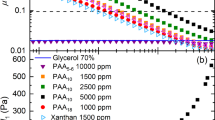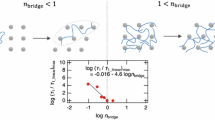Abstract
THE shear of a non-Newtonian body, that is, a plastic material or a high-polymeric pseudo-fluid, follows a mechanism showing analogy to that of a true fluid as expressed by the Maxwell equation; but whereas the relaxation of true fluids is purely time-dependent, in the case of non-Newtonian bodies a critical angle of tangential deformation characteristic for each material marks a threshold limit of elastic deformation before relaxation sets in. This elastic limit in plastic materials corresponds to the separation of a secondary aggregate into primary particles and, in the case of pseudo-fluids, to the inception of unkinking of the polymer molecules.
This is a preview of subscription content, access via your institution
Access options
Subscribe to this journal
Receive 51 print issues and online access
$199.00 per year
only $3.90 per issue
Buy this article
- Purchase on SpringerLink
- Instant access to full article PDF
Prices may be subject to local taxes which are calculated during checkout
Similar content being viewed by others
Author information
Authors and Affiliations
Rights and permissions
About this article
Cite this article
DE WAELE, A., LEWIS, G. The Rheological Curve. Nature 172, 298 (1953). https://doi.org/10.1038/172298a0
Issue date:
DOI: https://doi.org/10.1038/172298a0



